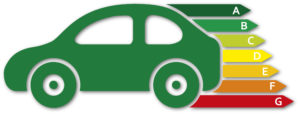EVALUATION OF UK FUEL ECONOMY INFORMATION FOR CARS
ENSURING THAT CONSUMER INFORMATION ON THE FUEL ECONOMY AND CO2 EMISSIONS OF NEW CARS IS STILL RELEVANT
The provision of information to consumers is useful as it helps them to make informed decisions about new cars that they are considering buying. Information on the CO2 emissions and fuel economy of new cars helps buyers to understand the environmental and economic performance of different vehicles. Since 2001, UK legislation has required that information on the CO2 emissions and fuel economy of new cars is communicated to potential buyers on a car label, and via other means. As a result of subsequent developments, it was important to evaluate the legislation to ensure that it was still relevant to potential car buyers. In 2018 TEPR, with the LowCVP, evaluated the relevant legislation for the UK Department for Transport. This report has now been published.
EU Directive 1999/94/EC
The requirement to provide information on a new car’s CO2 emissions and fuel economy to potential car buyers on a label was set in an EU Directive in 1999. The label has to be placed on, or near, new cars in a car showroom. The Directive also required that the same information be communicated on a poster in the car showroom, on promotional material and in a guide that enabled consumers to compare the models of different manufacturers.
New label
The Directive only contained basic minimum requirements on how the information should be presented. Initially, the UK followed the basic approach of the Directive. However, in 2005, a new label was launched in the UK as a result of a cross-industry dialogue led by the LowCVP.
The approach taken was to base the new car label on the energy efficiency label that was already used on domestic appliances, such as fridges and washing machines, and which can now also be seen in many non-residential buildings and on new car tyres.
In addition to the colour-coded set of arrows, the new car label also includes information on the estimated annual fuel cost and annual road tax (or Vehicle Excise Duty) that owners will have to pay. Examples of the current label can be downloaded from the VCA’s website.
Subsequent developments
Since the introduction of the relevant UK legislation, there have been many changes to the way in which cars are purchased, and also to the type of cars on the road. The use of the internet is now a fundamental part of most of our lives, and many potential car buyers undertake a lot of online research on new cars before even visiting a car showroom.
The fuel efficiency of new cars has also improved, and so CO2 emissions have declined. New ways of powering cars are increasingly common, with the increase in the number of electric cars, plug-in hybrid cars and even cars fuelled by hydrogen that are on the market.
The importance of evaluating the legislation
While these changes have occurred, the information that is contained on the label, and the ways in which the information is communicated, have remained unchanged. Hence, it was important to evaluate the legislation to identify the extent to which the information, and the means of communicating it, are still relevant to car buyers and the car market. This will help to identify any changes that might need to be made to ensure that the label remains a relevant means of communicating information on a new car’s CO2 emissions and fuel economy to potential new car buyers.
The UK Department for Transport commissioned the LowCVP and TEPR to evaluate the legislation. This included a survey of new car buyers and a survey of car dealers, as well as interviews with manufacturers and selected car dealers. The report has now been published.
More information
The report itself, as well as other reports that TEPR has been involved with relating to the Directive, can be found on TEPR’s website. Please contact TEPR on +44 (0)7521 063324 for further information on this and for other work that TEPR has carried out on the label, or email Ian Skinner (ian.skinner@tepr.co.uk).


Leave a Reply
Want to join the discussion?Feel free to contribute!